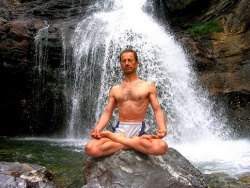Difference between revisions of "Two Dimensions of Meditation"
(Created page with "There are as many approaches to meditation as there are masters, and yet this is one aspect of Buddhist practice people can be very dogmatic about. Simply put, the goal of any...") |
|||
| Line 19: | Line 19: | ||
[http://www.thaibuddhism.net/meditation.htm thaibuddhism.net] | [http://www.thaibuddhism.net/meditation.htm thaibuddhism.net] | ||
| − | [[Category:Meditation]] | + | [[Category:Meditation]]{{BuddhismbyNumber}} |
Latest revision as of 10:17, 22 April 2014
There are as many approaches to meditation as there are masters, and yet this is one aspect of Buddhist practice people can be very dogmatic about. Simply put, the goal of any meditation exercise is to allow you insight into a process that can be applied to daily life experiences. In the beginning we may be asked to (painfully) sit still, but in the end we must step out of the meditation hall and apply our practice in every walk of life. How can we do this?
Concentration (samatha or samadhi)
Often referred to as one-pointedness, this fundamental dimension of meditation essentially involves focusing attention. Most often this is done in Thailand by focusing on the breath or counting the breath, similar to Zen meditation (zazen). Thai monks often refer to this method as phuttho (using the name of the Buddha as a mantra while breathing in and breathing out [haichai khao-haichai ok]). The point of this practice is to still the mind, in a sense arrest the monkey nature of thought that tends to swing from idea to idea just for fun. To put it another way, it is a means of letting the dust settle. If the mind is muddy like a murky pond, the only way for us to really see what is on the bottom is to be quiet long enough to let the silt fall — then if anything moves, we will know what is what. And this brings us to the next step...
Dynamic Insight (vipassana)
Once focus of attention has been established and distractions minimized, the meditator is in a position to begin practicing insight meditation. This type of meditation involves a conscious return to activity and observing the movement of the mind. With this method of meditation, The Four Noble Truths are reconsidered as a description of the dynamic thought process. In other words, thoughts arise; there is a reason why thoughts arise (AND persist); thoughts pass away; and there is a way to understand this whole process.
In a sense, insight meditation returns to a stirring of the mind — but with a new awareness. The thought process is freed but is observed with fresh eyes. The dynamic nature of thought is watched and when the flow of thought is impeded, the observer looks at the reasons why a particular thought may be attractive. Attachment or clinging to thought is observed in this way. The root of emotions can be understood by such observation. Some monks liken this process to watching the same movie over and over again. When we cling to thought, for whatever reason, watching its return is like watching reruns, “Oh, I’ve seen this one before....” In this way, emotions and thoughts are not controlled, rather they are grasped as they arise and can be rechanneled or dealt with properly before we become fixated or hung up on them.
While Concentration meditation aims at limitation and control, Dynamic Insight meditation seeks to expand and grow. After observing the movement of thought, many forms of Insight meditation also incorporate physical movement. This could be as subtle as rubbing the thumb and the forefinger together, it may employ hand movements, or it could involve walking back and forth. Walking meditation may look like the activity of a pacing, worried person, but it is quite the opposite. The eventual idea is to walk on from your meditation and have there be no distinction between this “path” and the course of daily life.
Afterthoughts
In the process of making this website, some of us became very absorbed in this enjoyable activity. Much of the research and writing was done while we were multitasking, maintaining and troubleshooting other computers in a multimedia learning center. Occasionally, when things distracted us from the website work, we observed ourselves begin to get a bit irritated or slightly resentful about being distracted, but we were able to catch this. This, to us, became part of the exercise of meditation. Also, I thought of another colleague who had always wished that he could quit his job and just meditate — wouldn’t that be ideal? He eventually passed away very suddenly and never seemed to find a way to incorporate meditation practice into his more mundane daily life. Buddhism seeks to eliminate such dualities and distinctions.

